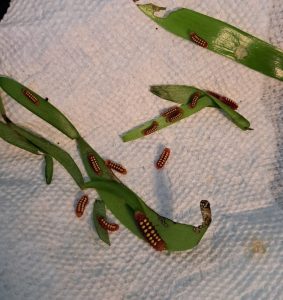In-A-Pinch Preventative Measures
Transfer and Retransfer:
A great help to the coonties during the Atalas’ peak munching period is to transfer the bigger caterpillars from the newer growth to older leaves or to a bigger plant that is better able to withstand the chewing. The caterpillars go through several instar phases before pupating and can tolerate transferring them in the latter phases. Moving the Atalas to other coonties provides the newer leaves more time to grow. This maneuver usually works for me without a hitch. Sometimes there is a caterpillar that wants to move back or find another option. When I notice this, I accommodate and try another spot.
Gifting:
My last in-a-pinch option to balance the needs of the coontie and the butterfly is to gift the caterpillars to other gardeners. There are pros and cons to these preventative measures. I find that gifting has its own rewards and challenges. On the one hand you are helping another Atala admirer to have Atalas in their garden, but issues do arise. The person may have insufficient nectar and/or larval host plants. Or the caterpillars may not take to their transplant coonties. The older caterpillars may do better as they have the option to pupate at an earlier instar stage and fly off later.
A very important note if you are receiving or gifting Atala caterpillars is to provide them with sufficient coontie leaves for the journey to their new home. Keep the journey as short as possible, minutes rather than hours. Under certain circumstances, this one included, Atalas will resort to eating each other. 
I inquire about the new home’s resources before gifting my caterpillars and accept that some do not make it. It is not an easy decision for me to make; however, not being proactive about a population explosion can lead to them flying off after depleting your garden’s coonties. Your coonties can quit flushing out, cave into a pest infestation, and die. I have coonties that have gone over a year without flushing new growth. I have also resorted to pruning all old growth to encourage the coontie to flush out new growth, as they would naturally after a pineland fire. Coonties are hearty plants and many rebound. It is also understandable their waiting for the coast to clear.
It is best not to take the Atalas flying off as a failure. They are alerting you to do more prep work. This is a good time to add more nectar, larval host plants, or shelter areas, while the coonties rest. You will be better prepared for the following season! Take the time to build a healthy well-balanced environment.
 2
2
